Texas is one of the largest Watermelon producers in the United States and has a long history of growing and eating Watermelons. Most of the commercial Watermelons in Texas are grown in seedless varieties. Let’s check out more information about Watermelon farming in Texas below.
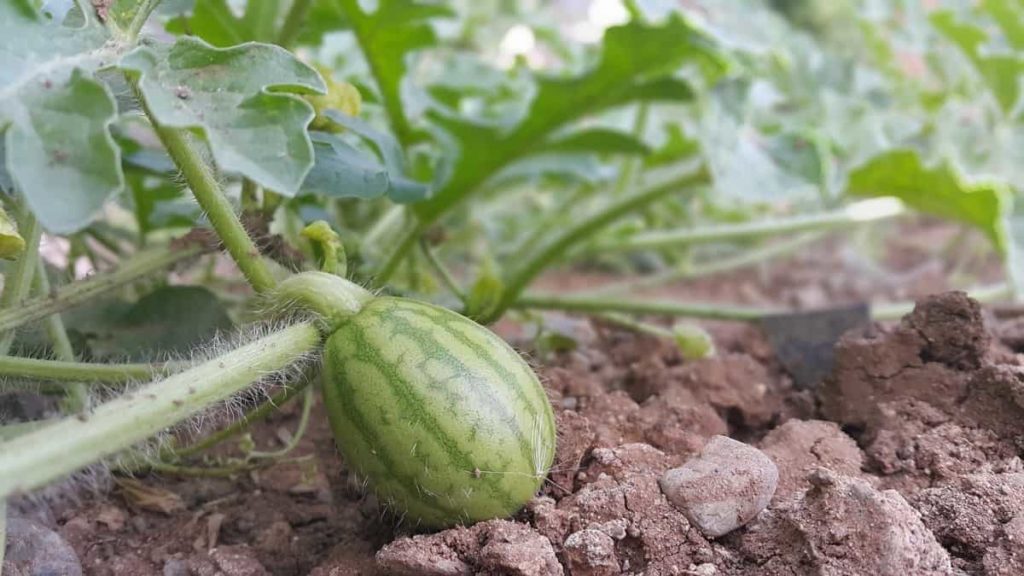
Different Watermelon varieties in Texas
- Sugar Baby Watermelon: This small, round Watermelon weighs only 6-8 pounds. Its skin is dark green and sweet, red flesh.
- Crimson Sweet Watermelon: This large Watermelon can weigh up to 20 pounds. It has dark green flesh with deep red flesh. The taste is sweet and juicy.
- Yellow Doll Watermelon: It is small and round like a sugar baby. However, its skin is pale and light pink flesh.
- Texas Watermelon: This large, tall Watermelon can weigh up to 40 pounds. It has green color skin with deep red flesh.
In Central Texas, there are several recommended Watermelon varieties, which are planted in the spring for the summer crop:
- Black Diamond Variety (bright red flesh, dark green rind, juicy, sweet)
- Crimson Sweet (dark and light green stripes, red meat, very sweet)
- Charleston Gray (medium green rind, red meat, crisp, without fiber)
- Bush Sugar Baby (dark and light green stripes, red meat, flavorful)
- Jubilee (dark green and light stripes, crispy, flavorful)
In case you missed it: Watermelon Farming in California: How to Start, A Step-By-Step Guide for Beginners
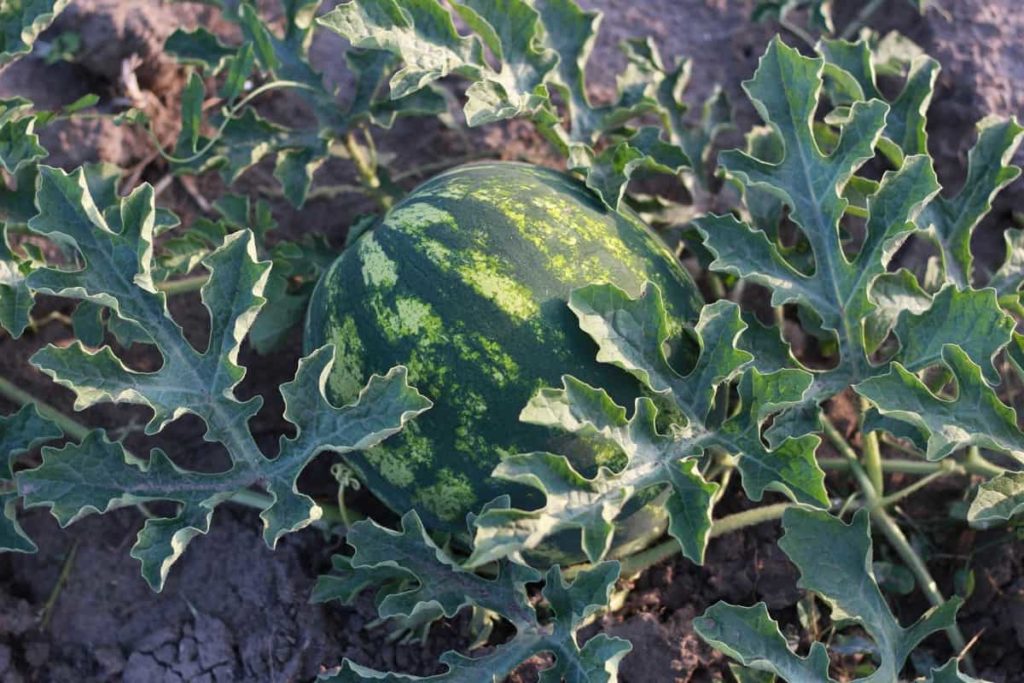
The best varieties of Watermelon for North Texas
- Sugar Baby: 80 days. Produces 10 lb melons with bright red meat. This small variety can only be planted at a distance of 4 feet.
- Charleston Gray: 87 days. Produces long gray-green skin and red flesh. Fruits can grow up to 20-40 pounds.
- Crimson Sweet: 80 days. Large, round melons that weigh an average of 25 pounds are light green with dark green stripes. The flesh is deep red, strong, and well textured. Resistant to Fusarium Wilt and Anthracnose.
- Jubilee: 90 days. Tall, oval fruit with red flesh.
- Black Diamond: 90 days. ‘Black Diamond’ is the best Watermelon. Also called the “king” of Watermelon, it can weigh up to 50 pounds. Its sweet, juicy flesh is bright red and soft.
Some other Watermelon varieties are;
- Hybrids – Stars-N-Stripes, Summer Flavor, 800, Big Stripe, Royal Sweet, Jamboree, Stargazer, Dulce, Ole, Sangria, Summer Flavor, 810
- Seedless (Triploids) – Crimson Trio, Tri-X313, Carousel, Dillion, Summer Sweet, 5244, Gem Dandy, Tri-X Palomar, Sweet Slice
- Long Seedless – Revolution
- Open Pollinated – Jubilee II, Legacy
- Yellow Flesh – Gold Strike (Orange Flesh), Summer Gold
Tips for growing Watermelons in Texas
- Choose the right variety – There are wide varieties of Watermelon, and some are better than others for the Texas climate. Do some research to find the type that works best in your area.
- Start with healthy plants – Once you have chosen your type, it is important to start with healthy plants. You can either grow the seeds or buy young plants from the nursery.
- Plant in the right place – Watermelons need full sun and well-drained soil to thrive. Choose a place in your garden that meets these needs. If you are growing your Watermelons in containers, make sure the pots are at least 20 gallons in size.
- Water regularly – Check the soil moisture level frequently and water accordingly. Watermelons are thirsty plants, so they must be watered regularly – especially in hot, dry weather.
Where are the most Watermelons grown in Texas?
Watermelons are grown in about half of Texas counties. However, a significant amount of this product is in a small area which is not considered a commercial product. The top five Watermelon-growing counties are Hidalgo, Brooks, Know, Gaines and Wood.
In case you missed it: Watermelon Farming in USA: How to Start, A Step-by-Step Guide for Beginners
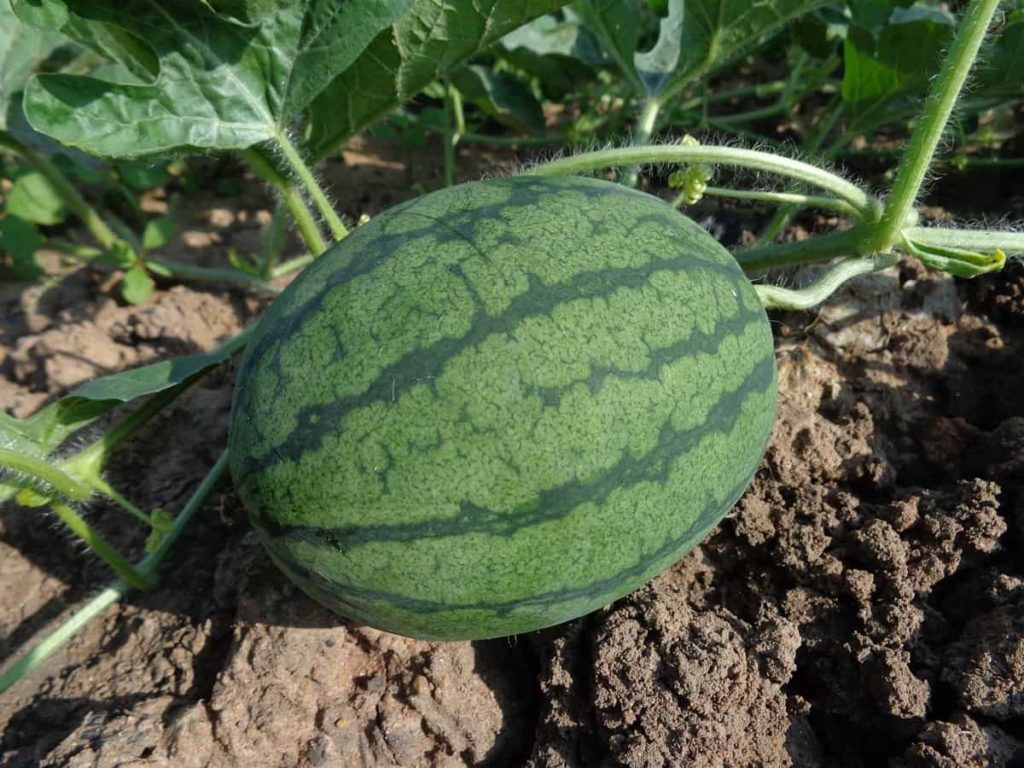
Watermelon is an annual crop in Texas. Harvest begins in early May in the Lower Rio Grande Valley (South Texas), June in the west of San Antonio (Wintergarden), June – July in East Texas, late summer – Early autumn in the Cross Timbers area, and beginning in September and October in the highlands. About 80 percent of Texas Watermelon production is marketed in June, July, and August. The best marketing window is mid-June-July.
Watermelon Cultivation in Texas
In the United States, Texas ranks first in the number of acres used for Watermelon production and third in production volume. It is grown in about half of all Texas counties, but many of these products are not considered commercial and end up at farmers’ markets and roadside stalls.
The majority of Texas commercial Watermelons are seedless Watermelon varieties. Watermelon is the state’s largest annual crop, with cash receipts expected to exceed $ 50 million, and the overall economic impact across the state is estimated at more than $ 160 million. Texas is the third-largest producer of Watermelon in the United States.
Where to plant Watermelon
Watermelons need a lot of sun, a lot of nutrients, and a lot of room, so follow these three planting guidelines:
- Keep them in full sun – they thrive in the heat.
- Plant in a rich, well-composted loamy soil.
- Plant spacing varies depending on the type and size of the ripe Watermelon.
Soil and site selection for Watermelon farming in Texas
The best soil is deep, well-drained, and light-textured, with a pH of 5.5 – 8.0. Watermelon does not tolerate heavy soils. Watermelon is an annual crop in Texas. Each of Texas’ productive areas will often have unique pest problems. Diseases are a good example. Anthracnose and sticky stem blight are major problems in the northern part of the state but are generally not considered treatable in South Texas and Winter Gardens.
Watermelons are crops that require a lot of space, especially melons. For this reason, they are not suitable for small orchards and should be grown only in large orchards in urban areas or large orchards in rural areas. Watermelons can be grown in small orchards if the oxen are trailed, and the fruit is supported.
Watermelons grow best on a deep, well-drained, sandy, or sandy loam soil rich in organic matter. Heavy soils with too much soil often led to smaller, weaker plants that produce fewer melons. Watermelons prefer soil with neutral pH, and the plants will lose their flowers if the soil is very acidic.
In case you missed it: Top 20 Steps to Boost Watermelon Yield: How to Increase Fruit Size, Quality, and Production
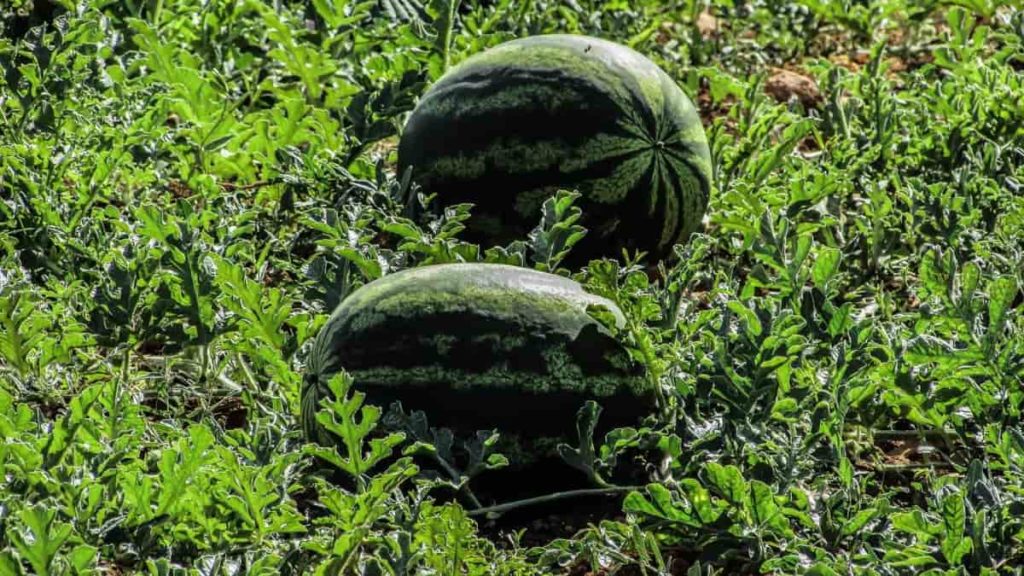
Watermelon cultivation practices in Texas
Watermelons grow best in sandy loam but tolerate heavy soils as long as the soil is well-drained. Generous spacing for underground root development and air circulation above the ground, especially for large fruit melons, will help prevent disease. To get peak yields, experts recommend keeping the plants 4 to 6 feet apart in rows, keeping a distance of 6 feet between rows.
These small varieties can be grown vertically on strong fences or trails to save space. As the melon grows, support each one in an old T-shirt or pantyhose for support. Watermelons require a long warm season from planting to harvesting, and Texas delivers. Seeds need more than 21°C of soil temperature for healthy germination.
Spreading the weather by planting in cold soil will produce seed rot or stagnant, slow-growing plants. The Watermelon seeds are sown directly into the slightly raised mounds of soil (hills). Prepare the hills a few weeks before your expected planting date by modifying with one layer of compost and about one cup of commercial garden fertilizer per hill—Water the hills a day or two before planting to moisten the soil.
When planting, plant three or four seeds on each hill, a few inches apart and about 1 inch deep. After two weeks, the seeds will start germinating in about a week and thin out to the two strongest plants on each hill. This thinning process is painful for many gardeners, but allowing the Watermelon plants to grow above and below the ground is important without overcrowding or competition.
When the plants bloom, sprinkle 2-3 tablespoons of high nitrogen fertilizer around each plant and side dress. Gently add the fertilizer to the soil and water well. Before they spread and provide moderate and constant moisture, ideally mulch with drip irrigation or soccer hoses to prevent the leaves from getting wet.
Excessive moisture near the harvest can result in bad taste, so stop watering two or three weeks before your expected harvest. Monitor pests, such as beetroot, and treat to prevent infection if necessary. Powdery mildew can be a common problem during the rains, but a precautionary measure – full sun, proper air circulation, drip irrigation – will help prevent the disease.
Irrigation management for fruit growth
The average demand for water in the Watermelon crop is about 10-15 inches per season. 1 to 2 inches of steady moisture is required at 7 to 14 days. Watering is very important. When melon plants grow, bloom, and bear fruit, they need 1 to 2 inches of water each week. Keep the soil moist but not full of water.
In the morning, apply water by hand to the vine’s base, and try to avoid wetting the leaves. Reduce water after fruit grows. Once the Watermelon fruit is the size of a tennis ball, reduce your water. Water only when the soil is dry, and the leaves show signs of wilting. The dry season produces the sweetest melon.
Fertilization for Watermelon farming
Fertilizer rates in Watermelon should be based on actual soil test results. Typical nitrogen, phosphorus, and potassium rates are 80, 80, and 80 pounds per acre, respectively. 40 to 50 pounds of nitrogen can be applied at or before planting, another 20-30 pounds can be side-dressed, and 20-30 pounds can be side-dressed at binding. 40 to 80 pounds of phosphorus can be tied about 2 inches below the seed when planting.
Most Texas soils have adequate potassium. 40 to 80 pounds of potassium can be added with pre-plant N if needed. Approximately 8 ounces of high phosphate starter solution can be applied in a field setting. As the vines are growing, use organic fertilizers with high nitrogen, such as 5-1-1 or 12-0-0. After flowering, switch to low nitrogen fertilizer. Side dress your plants with a high-quality organic fertilizer such as Espoma 5-1-1. When the melons are set, re-fertilize.
In case you missed it: Organic Watermelon Farming, Growing Practices
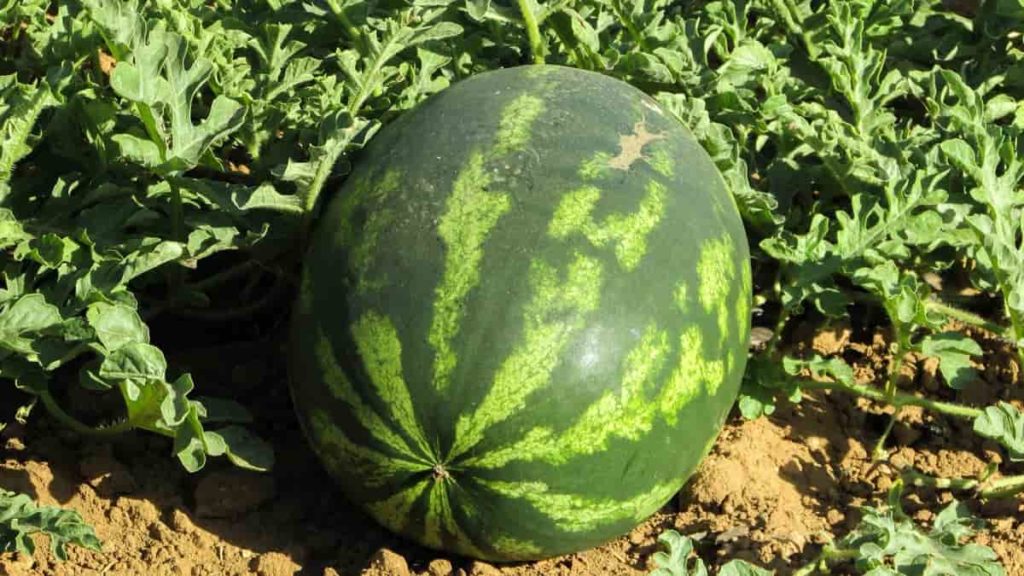
If you want to trellis your plants, you can relieve some stress on the vines by supporting the fruit with a netting, fabric, or pantyhose sling. Trellising improves air circulation around Watermelon plants and can help reduce plant disease problems. Choose smaller Watermelon varieties and reduce the distance between plants.
What month do you plant Watermelons in Texas?
When the soil warms up in mid-spring, plant melons will be in mid-April in North Texas, from late March to early April month in the central parts of the state, and from mid-March to late March along the coast. Before planting, apply 1 to 2 cups of complete fertilizer per 50 square feet in the garden bed area.
Pests, diseases, and their control in Watermelon
Watermelons are more likely to be attacked by cucumber beetroot or squash vine borers. They can also attract aphids. Floating row covers are not recommended as they may interfere with pollination. A better option would be to remove the squash vine borer traps or leave out the Trichogramma Wasps. Vine borer traps keep adult wine borer insects away from your plants while Trichogramma Wasps parasitize vine borer eggs.
Key insects include cucumber beetles, aphids, and squash bugs. Others include cutworms, cabbage loopers, leaf hoppers, leaf miners, Watermelon worms, pickleworms, mites, squash vine borers, and flea beetles.
Cucumber beetles can be controlled by spraying the plants with triple-action or dusting with Diatomaceous Earth (DE).
Fusarium wilt is a widespread plant disease caused by a fungus that lives in the soil. It thrives in warm temperatures and can remain in the soil for many years, even when no host plants are present.
Plants can start with healthy dark green leaves, but as the infection progresses, the leaves turn yellow, wither, wither and die. As they die, the lower leaves of diseased plants begin to fall off, and the symptoms gradually spread to the upper leaves.
Tips to prevent pests from invading your Watermelon plants
- To reduce the chances of diseases and pests growing, practice rotating the crop and avoid planting the family cucumber crops (melons, squash, pumpkins) in the same place for two consecutive years.
- Make sure the plants are healthy.
- Keep the area around the Watermelon plants clean.
- Use insect netting or row covers to keep insects away.
- Check the Watermelon plants regularly for signs of infection and take immediate steps to control the problem.
In case you missed it: Watermelon Seed Germination, Time, Temperature, Process
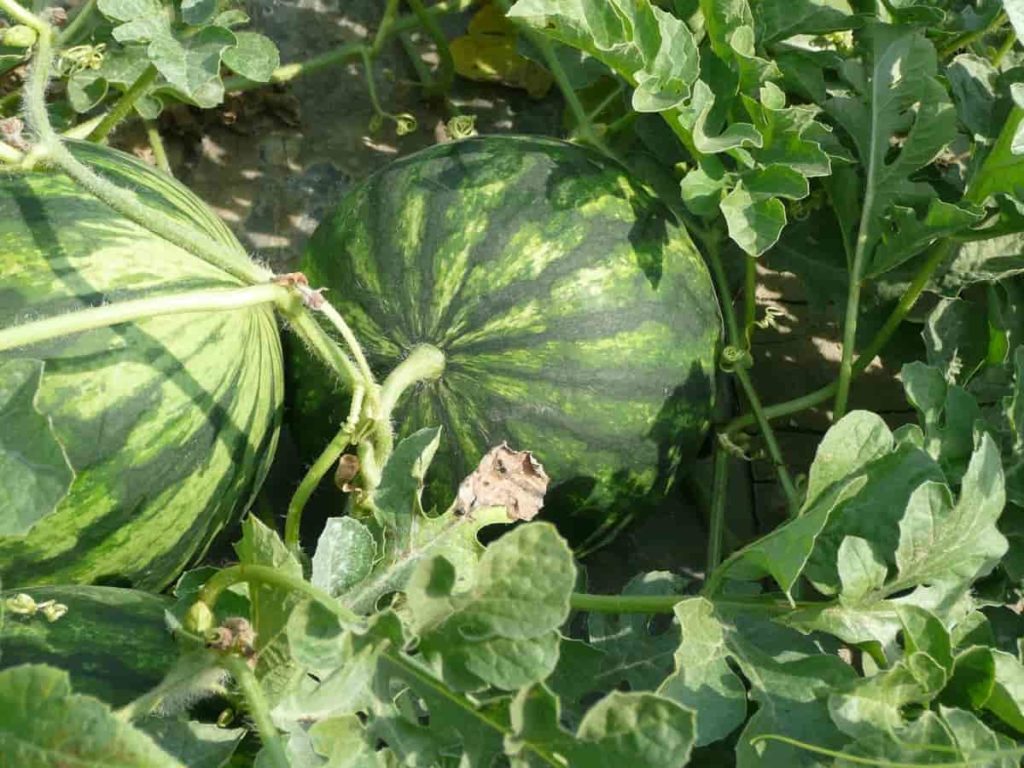
Weed management in Watermelon farming in Texas
Weeds are a constant problem in Watermelons in Texas. Plastic mulch has become an important tool in Watermelon weed management and water conservation. Weed control is essential to prevent mulch damage. Annual broadleaf weeds, annual grasses, and perennial grasses are targeted for herbicide use. Time of use and understanding of the life cycles of weeds are essential elements of successful control. Application times are pre-plant or pre-emergence, early post-emergence, and post-emergence.
Harvesting season for Watermelon in Texas
It is easier to pick ripe Watermelons in your garden than in a grocery store because there are many clues to see when you grow them yourself. First of all, the seed packet will tell you the approximate day of harvest for the specific type of crop you are planting.
In Lower Rio Grande Valley, the harvest season begins in April. Watermelons ripen in Winter Garden and East Texas in June and July, and the Rolling Plains area is ready for harvest in August. The Watermelon crop can be found in the southern highlands in late summer and early autumn.
Watermelons are usually ready for harvest in about 2-3 months. They should be dark green with no white spots. To check if the Watermelon is ripe, tap it – it should be hollow. You can also find a tendril on the vine that has dried up – a good sign that the Watermelon fruit is ripe and ready to pick.
Conclusion
Watermelon is the largest annual fruit crop in Texas and it is one of the most popular fruits in Texas. These fruits are a great source of hydration and vitamins, perfect for hot summer days. Please follow the above steps for Watermelon farming in Texas to get the best yield.
- Economical Aquaculture: A Guide to Low-Budget Fish Farming
- 15 Common Planting Errors That Can Doom Your Fruit Trees
- How to Make Houseplants Bushy: Effective Tips and Ideas
- Innovative Strategies for Boosting Coconut Pollination and Yield
- Pollination Strategies for Maximum Pumpkin Yield
- The Complete Guide to Chicken Fattening: Strategies for Maximum Growth
- Natural Solutions for Tulip Problems: 100% Effective Remedies for Leaf and Bulb-Related Issues
- Revolutionizing Citrus Preservation: Towards a Healthier, Greener Future
- Natural Solutions for Peony Leaf and Flower Problems: 100% Effective Remedies
- Maximizing Profits with Avocado Contract Farming in India: A Comprehensive Guide
- Natural Solutions for Hydrangea Problems: 100% Effective Remedies for Leaf and Flowers
- The Ultimate Guide to Choosing the Perfect Foliage Friend: Bringing Life Indoors
- From Sunlight to Sustainability: 15 Ways to Use Solar Technology in Agriculture
- The Ultimate Guide to Dong Tao Chicken: Exploring from History to Raising
- The Eco-Friendly Makeover: How to Convert Your Unused Swimming Pool into a Fish Pond
- Mastering the Art of Delaware Chicken Farming: Essentials for Healthy Backyard Flocks
- 20 Best Homemade Fertilizers for Money Plant: DIY Recipes and Application Methods
- How to Craft a Comprehensive Free-Range Chicken Farming Business Plan
- Brighten Your Flock: Raising Easter Egger Chickens for Beauty and Bounty
- How to Optimize Your Poultry Egg Farm Business Plan with These Strategies
- Subsidy for Spirulina Cultivation: How Indian Government Schemes Encouraging Spirulina Farmers
- Ultimate Guide to Raising Dominique Chickens: Breeding, Feeding, Egg-Production, and Care
- Mastering the Art of Raising Jersey Giant Chickens: Care, Feeding, and More
- Ultimate Guide to Raising Legbar Chickens: Breeding, Farming Practices, Diet, Egg-Production
- How to Raise Welsummer Chickens: A Comprehensive Guide for Beginners
- How to Protect Indoor Plants in Winter: A Comprehensive Guide
- Ultimate Guide to Grow Bag Gardening: Tips, Tricks, and Planting Ideas for Urban Gardeners
- Guide to Lotus Cultivation: How to Propagate, Plant, Grow, Care, Cost, and Profit
- Agriculture Drone Subsidy Scheme: Government Kisan Subsidy, License, and How to Apply Online
- Ultimate Guide to Raising Araucana Chickens: Breed Profile, Farming Economics, Diet, and Care
- Bringing Hydroponics to Classroom: Importance, Benefits of Learning for School Students
- Ultimate Guide to Raising Polish Chickens: Breed Profile, Farming Economics, Diet, and Care
- Ultimate Guide to Raising Australorp Chickens: Profile, Farming Economics, Egg Production, Diet, and Care
- Silkie Chicken Farming: Raising Practices, Varieties, Egg Production, Diet, and Care
- Sussex Chicken Farming: Raising Practices, Varieties, Egg Production, Diet and Care
- Homemade Feed Formulations for Livestock: Discover Cost-effective Starter to Finisher Feed Recipes